|
|
| |
QLogic Fibre Channel Switches
Tech Brief
Multi-switch Scalability in a SANbox Fabric
|
|
SANbox switches can be linked to create larger automated fabrics servicing
thousands of Fibre Channel storage and compute devices. To meet the
needs of various installations, QLogic offers a unique range of connecting
options, allowing customers to choose levels of resiliency,
scalability,
and performance
appropriate to their specific project and budget parameters.
All SANbox multi-switch
fabrics provide in-order delivery of frames through any number of
links, enabling load-sharing, fault failover and other configuration
possibilities. Customers can select from virtually unlimited wiring
alternatives in three distinct categories:
- Cascaded (Low cost,
smaller installations, low aggregate bandwidth)
- Mesh (Higher performance,
more resilient)
- Multistage™
(QLogic exclusive: Highest performance, lowest cost-per-gigabit,
highest resiliency, ideal for larger installations and/or tape
drives* -- see Notes.)
Option 1: Cascading QLogic's least expensive
connectivity option is similar to traditional network structures which
"daisy-chain" switches one after another (see illustration). Like
any topology that shares common resources among nodes, cascading is
most appropriate when aggregate bandwidth requirements are low or
when only a few devices need to be interconnected -- for instance
in test beds and other smaller installations.

Although well suited to certain applications, cascaded architectures
do not scale well. Adding switches can significantly reduce performance,
due to compound latency caused by multiple switch-to-switch "hops,"
and to the limited, shared E_port "pipeline." Bandwidth and latency
vary unpredictably depending on where messages enter and exit the
fabric, which means network planners using this approach must pay
close attention to changing traffic patterns when designing and
redesigning their system.
Option 2: Mesh ("Cascaded Plus") For projects
requiring a more predictable environment, mesh architectures offer
a cost-effective entry to true high-performance multi-switch
topologies. Because each switch is directly connected to every other
switch in the fabric, this configuration maintains a low hop-count
even as the fabric scales, minimizing bandwidth loss and the effects
of compound latency.
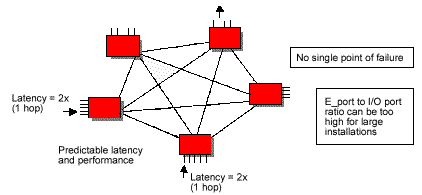
Eventually, however, the high number of required inter-switch connections
(E_ports) overwhelms the ability to add more I/O ports, creating
the need for a more flexible, robust strategy.
Option 3: Multistage™ Cross-Connect
For fabrics above 8-10 switches or for fabrics that require a high
degree of redundancy, QLogic's exclusive Multistage architecture provides
the ultimate high-bandwidth solution. In this topology, some switches
are dedicated to perform "cross-connect" functions, creating a variety
of performance, resiliency and cost-per-gigabit benefits not found
in any other configuration.
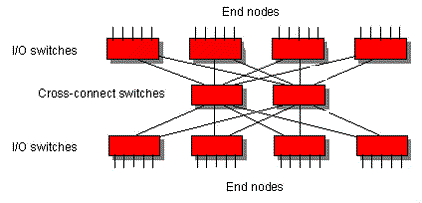
- Performance and Expandability
Multistage fabrics maintain the highest aggregate bandwidth by
allowing network designers to control the ratio of I/O ports to
cross-connect ports, creating as many redundant paths as necessary
to achieve a given performance goal.
Multistage networks can be expanded in three ways:
1. By adding more cross-connect links (Inexpensive Wiring-only
Expansion). This raises the overall fabric capacity and non-blocking
percentage (the percentage of time each port has uncontested network
access) without requiring additional switches, but does lower
the number of available I/O ports. 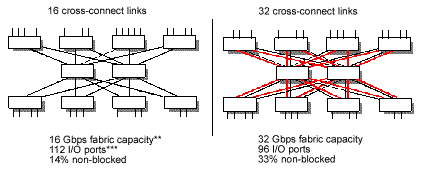
2. By adding additional I/O switches (I/O Expansion).
This increases the number of available end ports and overall fabric
capacity while incurring only a minimum of additional blocking,
depending on the number of cross-connect links used. 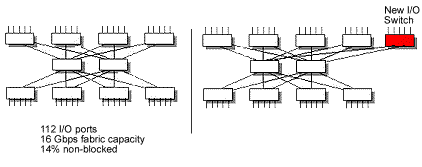
3. By adding additional cross-connect switches (Performance
Expansion). This raises overall system performance considerably
while maintaining approximately the same number of I/O ports.
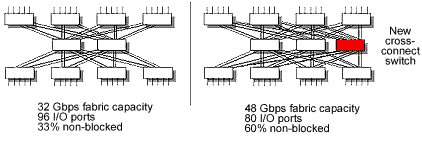
When the number of cross-connect links equals the number of I/O
ports, a 100% non-blocking configuration is achieved, and every
node can experience simultaneous full-duplex gigabit-per-second
access to the fabric. Large non-blocking configurations are not
possible with any other architecture.
- Resiliency
Multistage makes it easy to configure systems with no single point
of failure, since each I/O switch is linked to multiple cross-connect
switches. Redundant data paths mean that even in the unlikely
event of a total switch outage, the network as a whole continues
to function at normal or near-normal capacity. The following illustration
shows the effect of outages at different locations of a multi-stage
network.
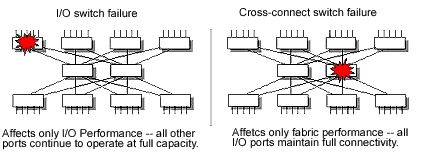
- Cost-per-gigabit
Finally, although Multistage environments can involve extra hardware
costs, their enhanced performance often makes up for this initial
expense when cost is measured on a per-gigabit basis. When the
economic impact of easy expandability and a truly resilient, fail-safe
infrastructure is factored in, multi-stage topologies provide
the best return on investment for a wide range of large and mid-sized
installations.
The three expansion methods (Cascaded, Mesh and Multistage)
can be applied individually or in combination, depending on
the desired performance and cost-per-gigabit affect.
Summary Points
QLogic provides three distinct methods of connecting multi-switch
fabrics: Cascaded, Mesh and Multistage.
All SANbox multi-switch fabrics provide in-order delivery of
frames through any number of links.
QLogic's exclusive Multistage cross-connect architecture offers
the following benefits:
- Predictable latency and performance (guaranteed bandwith)
- Highest aggregate bandwith
- Greatest expandability (Create large non-blocking fabrics)
- Greatest fabric resiliency (Create highly redundant configurations.)
For more information on how QLogic's multi-switch scalability
options can affect the cost and connectivity of your IT project, please call or
us.
Notes
* Fibre Channel-attached tape drives require guaranteed
bandwidth to maintain a consistent data stream to each drive's
recording head. Predictable performance, high reliability, and
the ability to create large 100% non-blocking architectures
makes multi-stage ideal for any environment that includes tape
drives.
** Refers to the fabric's end-to-end capacity. Actual capacities
are even higher for each of these examples when each I/O switch's
internal capacity is added.
*** Switch illustrations and examples used in this brief are
based on 16-port units. However, the capabilities discussed pertain
to all SANbox products.
SANbox, Multistage, QLogic and the QLogic logo are the marks
and property of QLogic, Inc..
|
|
|
|
|
|
|
|